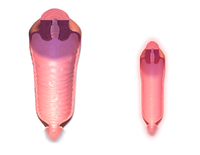
Photo from wikipedia
STUDY OBJECTIVE Previous studies suggest female-to-male transgender men tend to choose less invasive procedures, but the superior route of hysterectomy for them remains undetermined. DESIGN A retrospective study (Canadian Task… Click to show full abstract
STUDY OBJECTIVE Previous studies suggest female-to-male transgender men tend to choose less invasive procedures, but the superior route of hysterectomy for them remains undetermined. DESIGN A retrospective study (Canadian Task Force Classification II-3). SETTING An academic tertiary hospital. PATIENTS Fifty-six female-to-male transsexuals received total vaginal hysterectomy (VH) with bilateral salpingo-oophorectomy (BSO) between April 2008 and August 2016 at Taipei Veterans General Hospital, Taipei, Taiwan. INTERVENTIONS The patients underwent natural orifice transluminal endoscopic surgery (NOTES) (n = 14) or the conventional approach (n = 42). MEASUREMENTS AND MAIN RESULTS Medical charts and surgical records were reviewed retrospectively. The general characteristics of the patients were similar in both groups. There were no statistically significant differences in operative time, estimated blood loss, intraoperative and immediate postoperative complications, or length of hospital stay between the 2 groups. However, postoperative pain was significantly reduced in the NOTES group compared with the conventional group as evidenced by lower mean scores on the visual analog scale (4.9 ± 3.0 vs 7.1 ± 1.4 at 2 hours, p = .008; 1.5 ± 1.2 vs 3.0 ± 1.7 at 48 hours, p = .001; and 1.7 ± 1.0 vs 2.7 ± 1.1 at 72 hours, p < .001) and a lower mean accumulated dose of postoperative analgesics (38.9 ± 49.2 mg vs 88.8 ± 82.3 mg meperidine hydrochloride, p = .037). Analysis of variance with repeated measures with a Greenhouse-Geisser correction also showed that the mean scores for wound pain were statistically lower in the NOTES group (p < .001). There was no significant difference in the complication rate between the NOTES and conventional groups (7% vs 12%, p = .618). There were no severe complications, including infection episodes or internal bleeding events, within the NOTES group. CONCLUSION NOTES VH with BSO in female-to-male transgender men significantly decreases postoperative pain and analgesic use. NOTES in female-to-male sex reassignment surgery provides a novel choice for transgender men, with equivalent safety compared with VH.
Journal Title: Journal of minimally invasive gynecology
Year Published: 2019
Link to full text (if available)
Share on Social Media: Sign Up to like & get
recommendations!